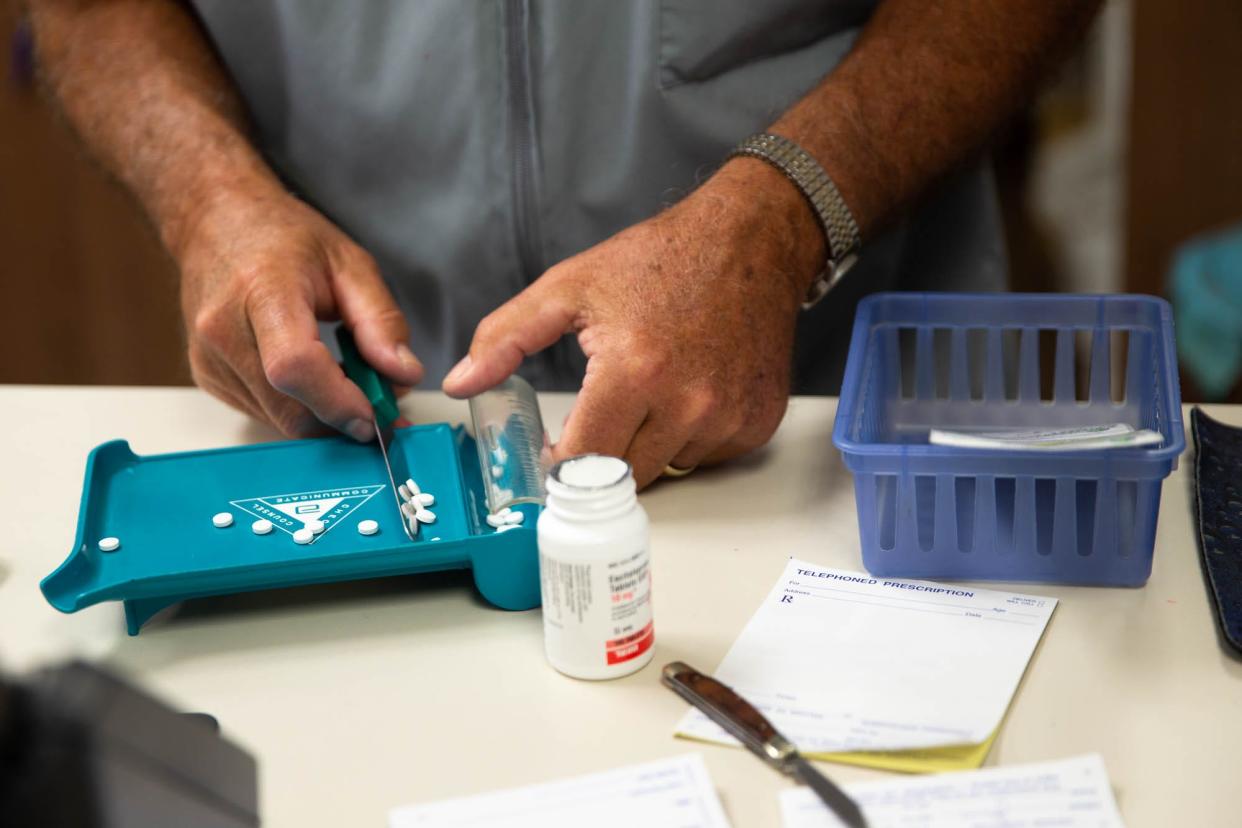Patients 'stuck in the middle' of battle over medication costs could get legislative help

- Oops!Something went wrong.Please try again later.
Madonna McGuire Smith, of Corvallis, has a husband and three children, each with a chronic bleeding disorder and each needing expensive medication.
She and her husband struggled to cover their yearly health insurance out-of-pocket maximum of $7,500.
“Every year we would scrimp and save,” she said.
Things became easier for their family when pharmaceutical manufacturers began providing copay assistance, which helps reduce total out-of-pocket costs for patients who need expensive medications.
But for many, insurer programs called copay accumulator adjustment policies (CAAPs) add a further hurdle, not counting that manufacturer coupon amount toward the patient's annual out-of-pocket maximum.
A bill in the Oregon Legislature this session proposes to change that, helping patients faced with chronic illness afford their necessary medications.
Failing grade
In a recent report, The AIDS Institute gave Oregon a low grade of D, for protecting copay assistance for patients.
The national advocacy group examined policy documents from six insurers that offered marketplace plans, or those found on the Health Insurance Marketplace, in Oregon.
Four of the six plans — BridgeSpan, Moda, PacificSource and Regencehad — had copay accumulators, meaning insurers are getting paid by both patients and pharmaceutical manufacturers.
Sixteen states have passed legislation that requires insurers to count third-party payments like copay assistance toward a patient's annual maximum, according to the AIDS Institute. Oregon could be next.
Lawmakers this session introduced Senate Bill 565, which would require state-regulated insurers to count all payments made towards a patient's copay, whether the payment was made by the patient themselves or through a copay assistance program.
“SB 565 is about centering this conversation on patients with chronic and rare disease,” said Sen. Sara Gelser Blouin, D-Corvallis, one of the bill’s sponsors. “It ensures they can access every tool they can find so they don’t have to choose between needed medications, food, housing costs and other essentials.”
The bill has been referred to the Senate Committee on Health Care. It's not yet scheduled for a public hearing.
'All Copays Count' coalition advocates for accessibility
McGuire Smith’s 20-year-old son needs one dose per day of an injectable medication if he has a bleed. That dose costs anywhere from $8,500 to $10,000, she said.
Without copay assistance, they would be paying their entire out-of-pocket maximum for one dose.
McGuire Smith said they have been lucky to be able to afford medication for their family, but this is not true for everyone.
People with lower incomes or other economic barriers may lose access to medications needed to treat chronic illnesses because of CAAPs.
“You’re forcing people to make a choice between housing and medicine,” McGuire Smith said.
McGuire Smith is the executive director of Pacific Northwest Bleeding Disorders, an organization that worked with Disability Rights Oregon and the All Copays Count Coalition to advocate for SB 565.
The All Copays Count Coalition includes more than 80 organizations nationwide, including the AIDS Institute, that advocate for people with chronic illnesses who need access to continuous, often expensive treatment.
Legislative action to allow for copay assistance and ban CAAPs for medications that do not have a generic alternative is their main goal.
Stephanie Hengst, manager of policy and research at the AIDS Institute, said in most chronic cases, access to medication is a form of continued management of a disease. But in some cases, like with hemophilia, it is life or death.
The AIDS Institute report on protecting copay assistance looked at the impact of increased costs for treatment due to CAAPs and found that of individuals surveyed, 8% reported delaying care, 7% did not get care, and 9% reported either delaying or not receiving care due to costs.
“These are patients, real people that are being impacted,” Hengst said. “And there's a very simple solution. Simply count their copay assistance towards the deductible and their out-of-pocket costs.”
What’s happening in Oregon?
This is the second legislative session in which this bill has been introduced. The bill passed in the Senate with a 29-1 vote in 2021, but did not make it through the House due to early adjournment.
Gelser Blouin said this is a debate between insurance and pharmaceutical companies about who carries the burden of the cost of these more expensive medications.
“Stuck in the middle of that conflict is the patient who scrapes every last penny out of the couch cushions or sacrifices other necessities just to access the life-saving drugs they need,” she said.
If passed, this bill would only apply to certain medications that do not have a generic equivalent.
“As a public policy, I would much rather see companies realize smaller profits than see an Oregonian lose life years because they can’t access the drugs their doctor says they need,” Gelser Blouin said.
Sydney Wyatt covers healthcare inequities in the Mid-Willamette Valley for the Statesman Journal. Send comments, questions, and tips to her at SWyatt@gannett.com, (503) 399-6613, or on Twitter @sydney_elise44
The Statesman Journal’s coverage of healthcare inequities is funded in part by the M.J. Murdock Charitable Trust, which seeks to strengthen the cultural, social, educational, and spiritual base of the Pacific Northwest through capacity-building investments in the nonprofit sector.
This article originally appeared on Salem Statesman Journal: Patients 'stuck in the middle' of battle over med costs could get help

